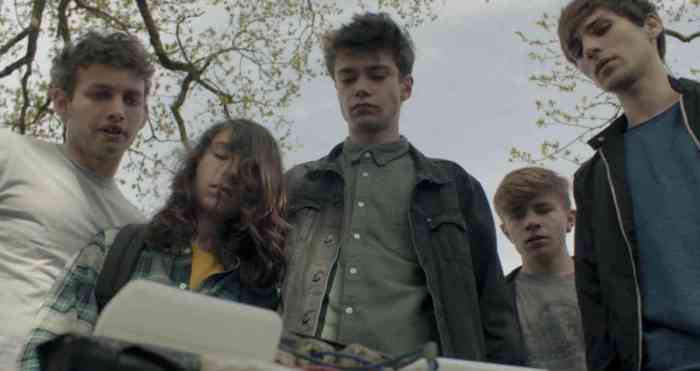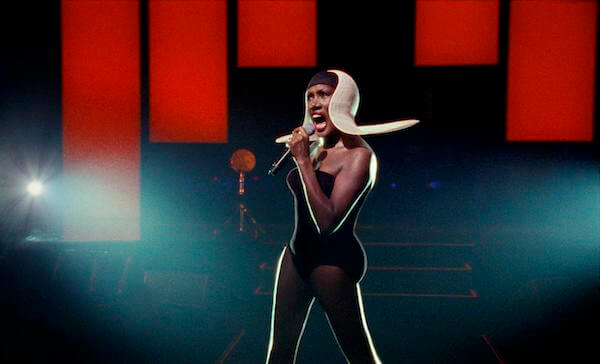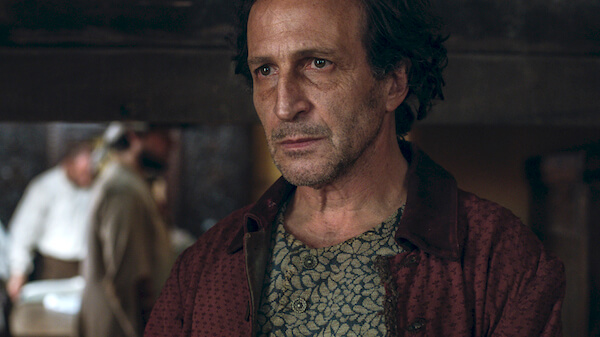Fred Astaire and Ginger Rogers in “The Gay Divorcee,” from 1934. | RKO/ KOBAL/ REX/ SHUTTERSTOCK VIA FILMLINC.ORG
The dog days of summer are already here, with wilting heat that makes escaping into an air-cooled moviehouse a highly sensible thing to do.
The greatest movie dance team is being celebrated by Film Society of Lincoln Center with a complete retrospective, “Fred and Ginger.” The series kicks off on July 13, a Friday but lucky this time, because no admission will be charged to see their 1933 debut film, the ultra-diverting “Flying Down to Rio.” The couple began in the movies as more comic-and-dance relief to this film’s official stars, two contrasting beauties: platinum blonde Gene Raymond and the darkly exotic Dolores Del Río, who, after Garbo, was considered the most beautiful woman in Hollywood. She wears a fabulous wardrobe, one of the first by the great screen couturiere Irene, and the film is a crazy-quilt pre-Code stew of lilting Vincent Youmans songs, Brazilian local color, dances that range from seriously orchidaceous tangos to the lively, branded “Carioca,” in which couples swing, pressing foreheads together with a certain erotic intensity, all of it culminating in the surreal title song number in which amazingly brave chorines are strapped to the wings of planes and borne aloft.
IN THE NOH: Gotham’s choicest film fests provide the perfect refuge
In their first starring vehicle which followed, in 1934, “The Gay Divorcee,” Astaire and Rogers graduated from hero’s antic sidekick and wisecracking band songstress to star-crossed lovers, and their romance found its first brilliant efflorescence in the “Night and Day” number, the single Cole Porter ditty retained from the Broadway musical, Astaire’s stage swan song. No dance possessing such suavely elegant grace and fervent emotional commitment had ever been seen on screen before, and it’s one of two terpsichorean highlights that make up for an idiotically contrived, low camp script that involves a lot of vehement and vehemently unfunny camping by series stalwarts fruity character men Edward Everett Horton and Eric Blore (with that hamstress Alice Brady thrown in, always given so little screen opportunity to really show her greatness as an actress who, indeed, was cast as Lavinia in O’Neill’s “Mourning Becomes Electra,” opposite no less than Nazimova).
The other highlight is, of course, a dance, and that would be the follow-up to the popular “Carioca,” “The Continental.” This catchy but throwaway song won the first Best Song Oscar, which is insane, because it was chosen over far superior ones that year: “Cocktails for Two,” “I Only Have Eyes for You,” and “I’ll String Along with You” — the latter two written by the superbly prolific team of Harry Warren and Al Dubin. There was also “Nasty Man,” “Here’s the Key to My Heart,” “An Earful of Music,” and “The Animal in Me,” none of which was nominated, proving yet again that the Oscars are artistically worthless.
With this film, the stars really hit their stride, with Astaire’s dancing becoming, if anything, even more stupefyingly flawless, complex, and inventive. And Rogers really blossomed, honing her delicious comic timing to match her musical sense of rhythm, and becoming sleeker and supremely glamorous as she twirled in gowns permanently imprinted on the minds of true fashionistas by the gifted likes of Irene, Howard Greer, and, especially Bernard Newman (responsible for the “Top Hat” feathered gown and the beaded, fur trimmed sheath for “Let’s Face the Music and Dance” in “Follow the Fleet,” later recreated for Bernadette Peters in the “Pennies from Heaven” homage to that number). Schiaparelli called Rogers the perfect American woman, and I confess to always watching her — so charismatically undulating and riveting — much more than Astaire, when they dance.
The Quad Cinema is presenting “The New York Woman,” through July 19, and quite marvelously curated with a mix of familiar titles and juicy rarities.
Edie Sedgwick in Andy Warhol’s 1965 “Poor Little Rich Girl.” | QUADCINEMA.COM
Now that legit porno theaters are a thing of our city’s pre-Disneyfied past, I think it will be a gas to catch Radley Metzger’s 1974 X-rated “The Private Afternoons of Pamela Mann,” starring hunky Eric Edwards, with what is likely to be the most meta Manhattan audience ever. Lizzie Borden’s prize-winning, rarely seen “Working Girls” (1986) focuses on a day in the life of a bunch of Upper East Side prostitutes, including an over-educated lesbian played by Louise Smith, who was nominated for an Independent Spirit Award. Gay German filmmaker Rosa von Praunheim’s doc “Tally Brown” (1979) focuses on the 1970s Warhol star who hung with Taylor Mead, Holly Woodlawn, and Divine. Warhol himself directed “Poor Little Rich Girl” (1965), starring tragic It Girl Edie Sedgwick, just a few years from her 15 minutes being over. Von Praunheim’s “Survival in New York” (1989), about — horrors! — immigrants from Germany tackling our then dirtier city, is also being shown. Photographer Nan Goldin makes an acting appearance in Bette Gordon’s “Variety” (1983), about a cashier in a Times Square porno house. Frederick Wiseman’s “Model” (1981), shot on location in the fabled Zoli agency, is a must-see, which this fashionista never has.
Joan Crawford’s most delicate and intelligent performance is showcased in Otto Preminger’s smart and satisfying “Daisy Kenyon,” which features fabulous Greenwich Village locations, like her Bohemian dream apartment and the old Greenwich Theater, and a subplot that features her rich, ruthless, highly appealing lover (an excellent Dana Andrews) as a lawyer caught up in reparation for Japanese internment victims. Another, more demure Gotham era is captured by the fun “The Best of Everything,” from Rona Jaffe’s best-seller about 1950s secretaries in the publishing world. One of them, tragic Gregg, is played by supermodel Suzy Parker, who slaves for one Amanda Farrow, a dragon lady of an editor, played by none other than Crawford again, much less sympathetic here, but in full, awesome star command. Preminger is also represented by “Such Good Friends” (1971), from his later, much less tasteful period, starring Dyan Cannon as a wife who discovers that her dying husband has schtupped all her friends. And how’s this for a cast: Laurence Luckinbill, Nina Foch, Rita Gam, Jennifer O’Neill, James Coco, Burgess Meredith, Doris Roberts, Louise Lasser, and penned by no less than Elaine May under the pseudonym Esther Dale, also the name of a beloved character actress always playing sage maids to the stars.
By some wondrous curatorial serendipity, a handful of films are included that happen to be among my top personal favorites. “Mixed Blood” is Paul Morrissey’s masterpiece, sick, wrong, and wondrous, with a posse of Lower East Side Brazilian and white trash trade (including Morrissey discovery, the beautiful, doomed Rodney Harvey, who worked with Coppola, Madonna, Bruce Weber, Gus Van Sant, Calvin Klein, and David Lynch, only to OD on heroin at age 30). The magnificent Marília Pêra gives one of the funniest, scariest, greatest performances in all cinema.
William Wellman’s “Baby Face’ (1933) has by now become everybody’s go-to pre-Code salacious treat, but it’s always welcome, especially for its prominent inclusion of black actress Theresa Harris, as, to quote one character, “that fantastic colored girl,” who would inspire Lynn Nottage’s play “By the Way, Meet Vera Stark.” Harris was a civil rights activist very early on and once said, “I never had the chance to rise above the role of maid in Hollywood movies. My color was against me anyway you looked at it. The fact that I was not ‘hot’ stamped me either as uppity or relegated me to the eternal role of stooge or servant. I can sing but so can hundreds of other girls. Hollywood had no parts for me.” In support of an African-American film production company, she said in 1937, “We have tolerated so many rotten pictures made in Hollywood by whites, I do not see why our own people cannot be tolerant in the pioneering stages of this company.”
Two beloved movies of mine are set in my neighborhood, the West Village. Nicole Holofcener’s “Walking and Talking” (1996) remains her most winning work for me, really capturing the nabe at its summer sultriest, and sparked by deeply lovable performances by Anne Heche, Liev Schreiber, Kevin Corrigan, Todd Field, and the director’s special muse, the always special Catherine Keener, who could possibly be the most New York woman onscreen ever. This is the kind of best friend movie that’s ideal for watching with that friend or facsimile or a very special date.
“The Seventh Victim” (1943) is the most fascinating film to come from the remarkable intelligent horror team of producer Val Lewton and director Mark Robson (his debut!), from a script by gay writer DeWitt Bodeen, about a girl (Kim Hunter) who comes to the Village to try to find her missing sister (haunting Jean Brooks). From its eerie opening and closing quotations from John Donne, and its moody wander through menacing nighttime subway rides, cafés with murals of Dante and Beatrice, enigmatic cosmetic companies bearing names like La Sagesse employing faintly predatory lesbians, culminating in a flat full of Satanists, this utterly unique film casts a febrile, ever-unsettling spell.
“Girls About Town” (1931) should be as well-known as “Baby Face,” another golddigger comedy and the film in which a young George Cukor really hit his wittily elegant stride, from a scintillatingly urbane script by hustler-gal specialist, the too-little-known Zoe Akins, also responsible for the verbal sophistication of the director’s masterly “Camille.” It has a terrific opening line — “It’s been an evil night,” muttered, while skulking in a nightclub powder room, by delicious, husky-voiced comedienne Lilyan Tashman, the Kim Cattrall of her day, and herself a pre-Code work of art, who tragically died of cancer in 1934, the year the Hays Code began, making her specific type seriously endangered. A feline Deco blonde, who had, according to Cecil Beaton, Hollywood’s best figure, she was both the best-dressed and horniest gal in town. Innocent females were seriously warned about going into the powder room with this ex-Follies Travis Banton-clad libertine, who, according to my friend actress Dorothy Mackaill, “wasn’t really beautiful, but it didn’t matter.”
Streisand lovers can thrill once more to her Oscar-winning renditions of the Herb Ross-directed “Don’t Rain on My Parade” number in “Funny Girl,” as well as the swoony velvety visuals of “My Man,” on the big screen where they should be, shot by veteran ace Harry Stradling, Jr. I must confess, however, to finding this film rather a bloatedly narcissistic showcase for its star, running two and a half hours. Musically speaking, just to see the divine Chita Rivera contorting in the “Hey Big Spender” number in Fosse’s “Sweet Charity,” not to mention the sexily writhing Suzanne Charny in the “Rich Man’s Frug” number or a hippie-beaded Sammy Davis, Jr. doing “Rhythm of Life” (“Crawl on your knees to Daddy”), makes “Sweet Charity” a must.
“Auntie Mame” and “Breakfast at Tiffany’s” are so familiar that it’s the incidental characters that grab my attention most now, in particular those fabulously vulgar, bigoted Upsons in the former (Joanna Barnes’ inspired Locust Valley lockjaw I’ve always wanted to ask her about, while veteran character actress Lee Patrick’s Doris hilariously channels both Billie Burke and then, suddenly and menacingly, Roseanne Barr in the the grip of an Ambien hate rant). In “Breakfast,” I keep waiting for the film to ditch heroine Holly Golightly and follow the further exploits of Patricia Neal’s wittily rapacious, uber-chic in Pauline Trigere vampire wear, character, known in the screenplay only as 2E. Her ruthless slice-and-dice dismissal of gorgeous George Peppard is something I’d like to achieve — classy and not screaming like a fishwife — if I ever find it necessary to rid myself of a young, beautiful parasite.
The festival will provide the chance to re-evaluate three performance that, in my opinion, are all modern classics. Has Sigourney Weaver ever been as hilariously on point as thesuperior boss bitch in “Working Girl” (“I am, after all, me”)? Another actress giving an iconic performance she would never top is Mia Farrow in “Rosemary’s Baby,” a movie filled to overflowing with icons in various states of decay — scenery-chewing character veterans Ruth Gordon, Patsy Kelly, Ralph Bellamy, Sidney Blackmer, and of course, its very setting, The Dakota. For those who cannot wait for the Broadway Cher musical, “Moonstruck” is on deck here, giving you that high diva at her most simple, womanly, and earthily charismatic, like Magnani-lite.
It’s 2018 and diversity is definitely in the air, as witness the two black heroines on view here (pardon my sarcasm), Ariyan Johnson as teenaged Project-dwelling Chantel in “Just Another Girl on the IRT.” Happily, director Leslie Harris will be on hand to describe how she made her movie in a breathless 17 days. Curtis Mayfield’s percolating music, sung by Gladys Knight & the Pips, fuels “Claudine,” the winning Diahann Carroll/ James Earl Jones blue collar romance.
“Smithereens” (1982), Susan Seidelman’s time capsule of a vanished, fabulously raffish East Village, which rather brings a tear to me eye, will be screened on July 14. This echt-New York auteur said in a recent interview with AMNewYork, “The city provides a perfect setting for stories about women who are seeking something — whether it be work, romance, adventure, or the freedom to simply live their lives on their own terms. Learning how to navigate the frenetic push and pull of NYC life can be exciting or challenging — but it makes you tough.”
FRED AND GINGER: A COMPLETE RETROSPECTIVE | Film Society of Lincoln Center, Walter Reade Theater, 165 W. 65th St. | Jul. 13-15 | filmlinc.org
THE NEW YORK WOMAN | Quad Cinema, 34 W. 13th St. | Through Jul. 19 | quadcinema.com



































